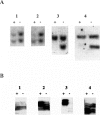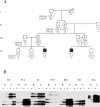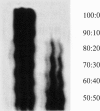Abstract
The human androgen-receptor gene (HUMARA; GenBank) contains a highly polymorphic trinucleotide repeat in the first exon. We have found that the methylation of HpaII and HhaI sites less than 100 bp away from this polymorphic short tandem repeat (STR) correlates with X inactivation. The close proximity of the restriction-enzyme sites to the STR allows the development of a PCR assay that distinguishes between the maternal and paternal alleles and identifies their methylation status. The accuracy of this assay was tested on (a) DNA from hamster/human hybrid cell lines containing either an active or inactive human X chromosome; (b) DNA from normal males and females; and (c) DNA from females showing nonrandom patterns of X inactivation. Data obtained using this assay correlated substantially with those obtained using the PGK, HPRT, and M27 beta probes, which detect X inactivation patterns by Southern blot analysis. In order to demonstrate one application of this assay, we examined X inactivation patterns in the B lymphocytes of potential and obligate carriers of X-linked agammaglobulinemia.
Full text
PDF
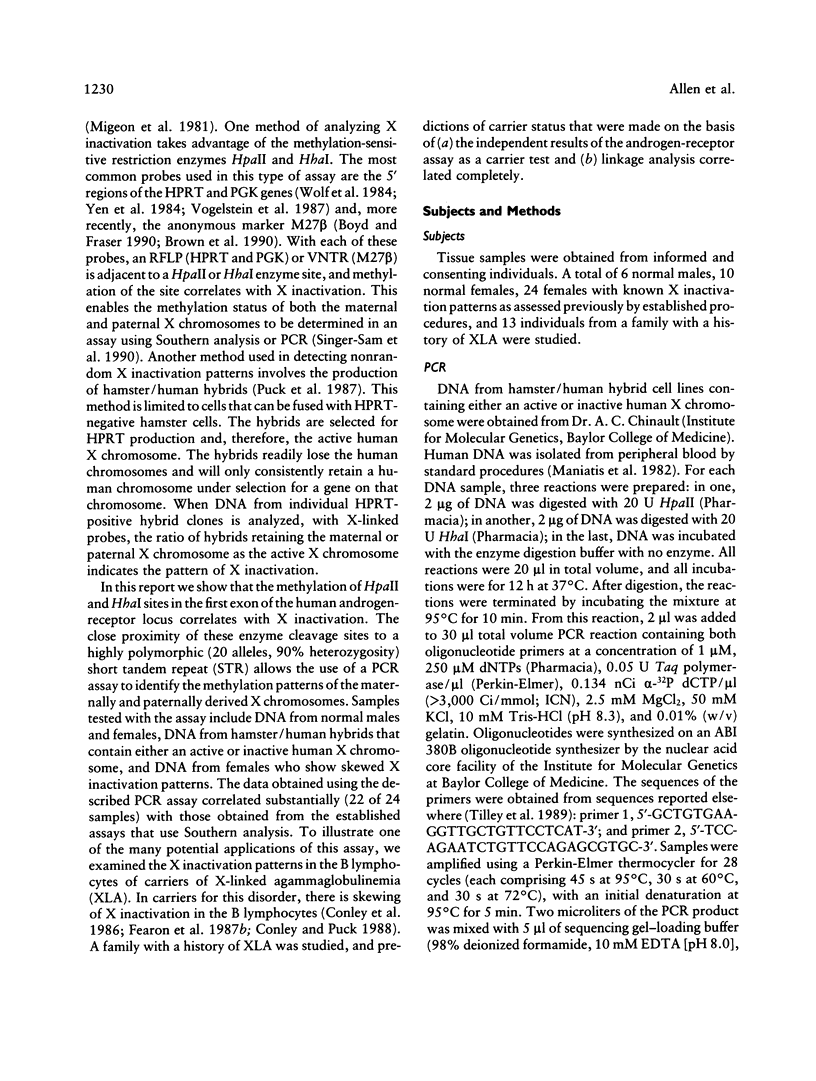
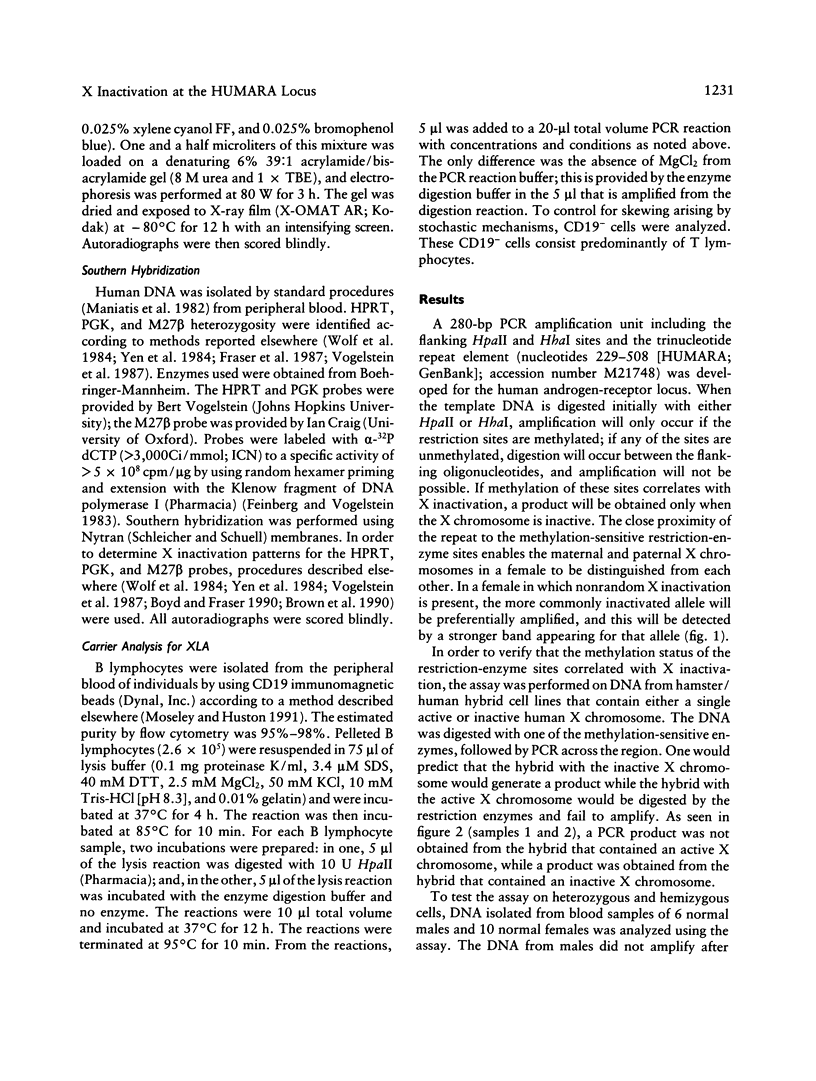
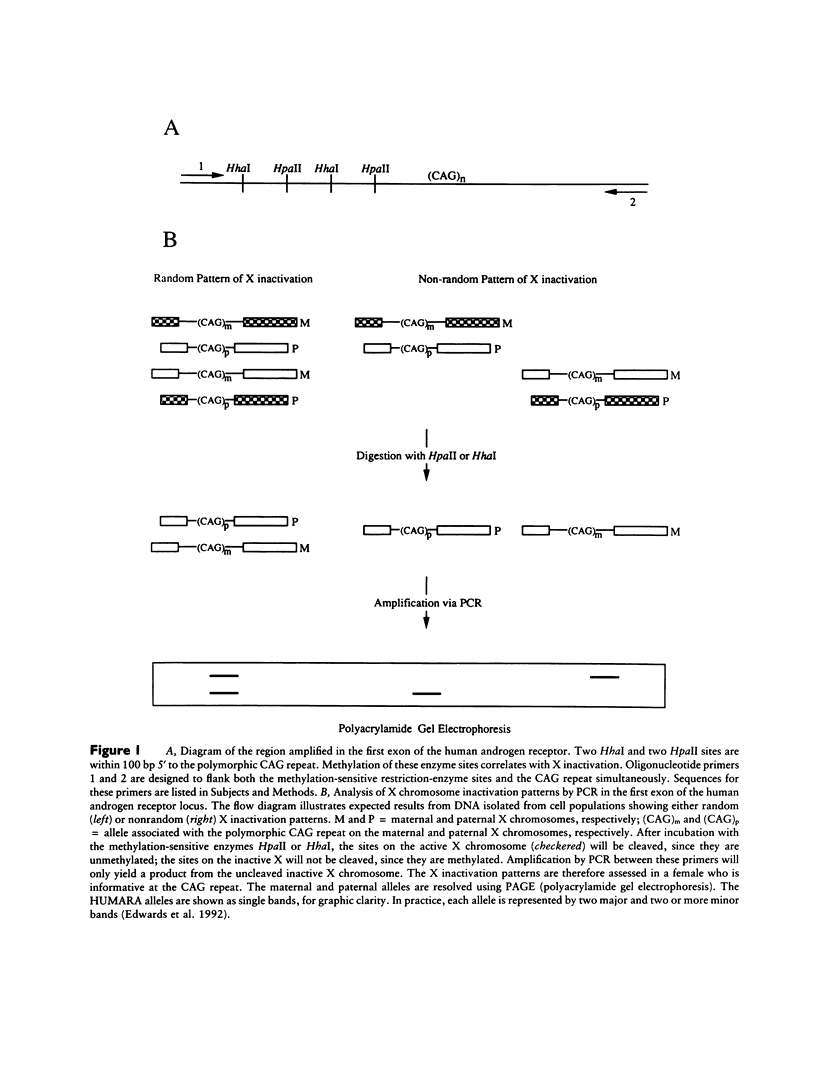

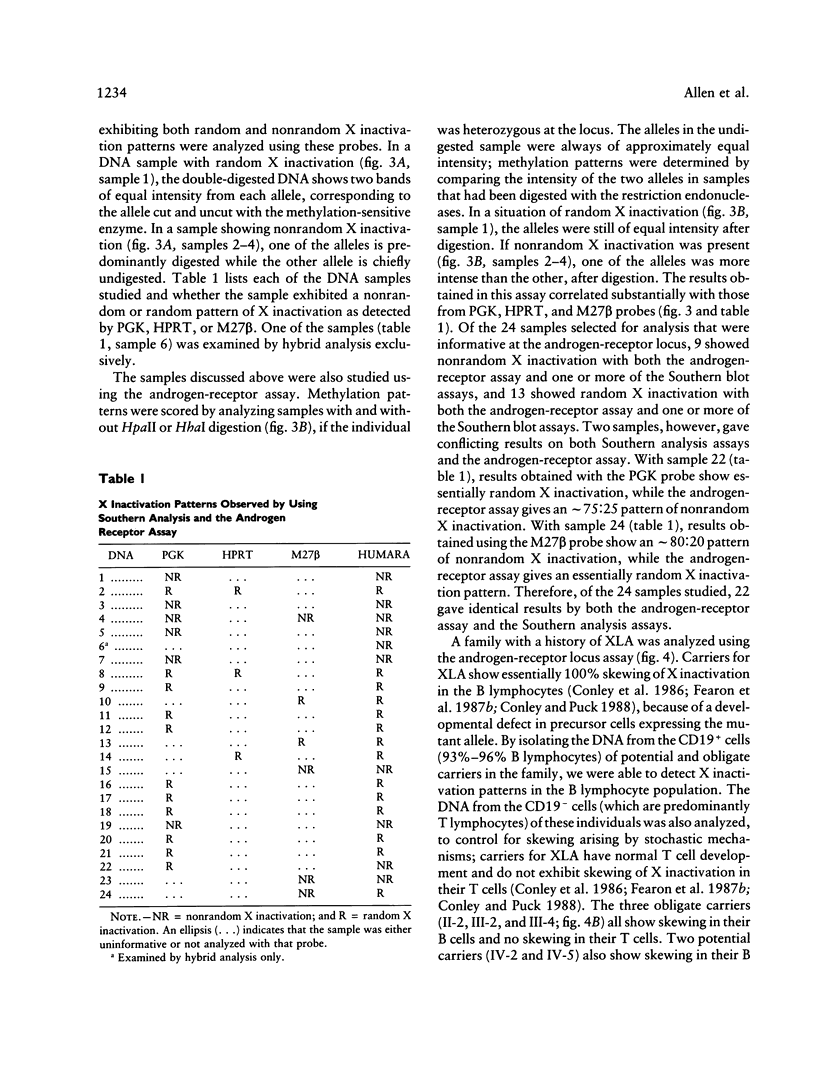
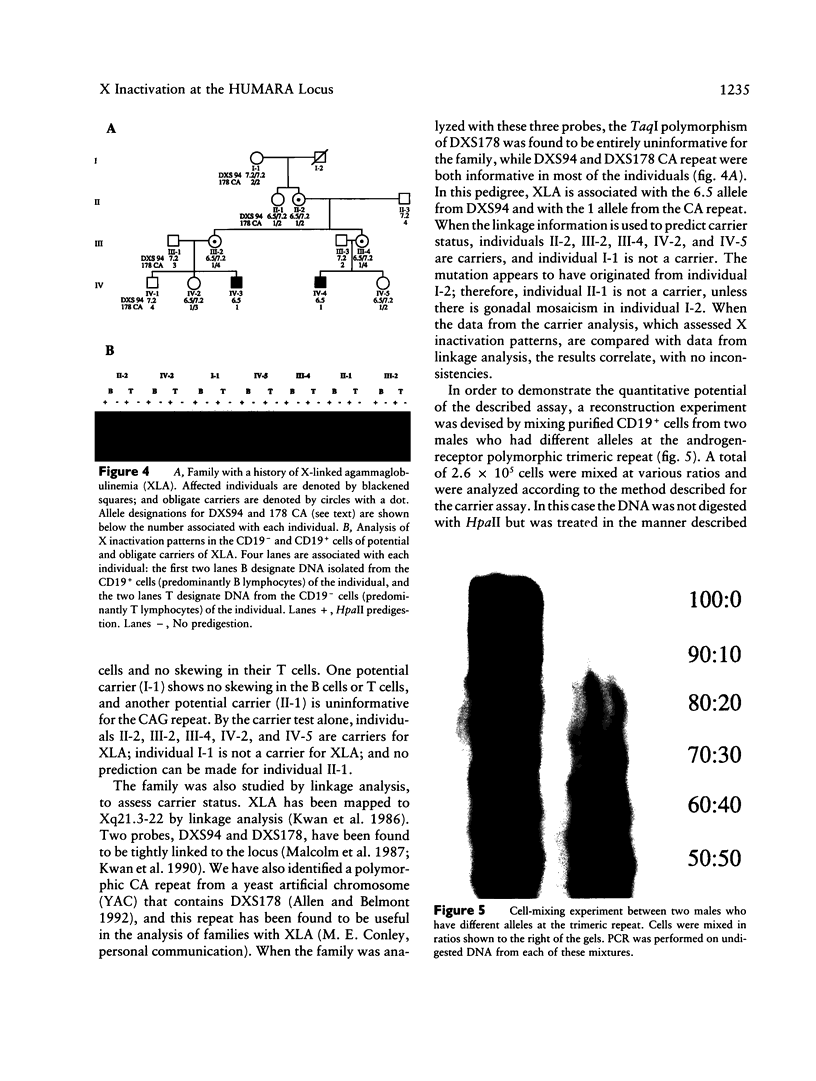
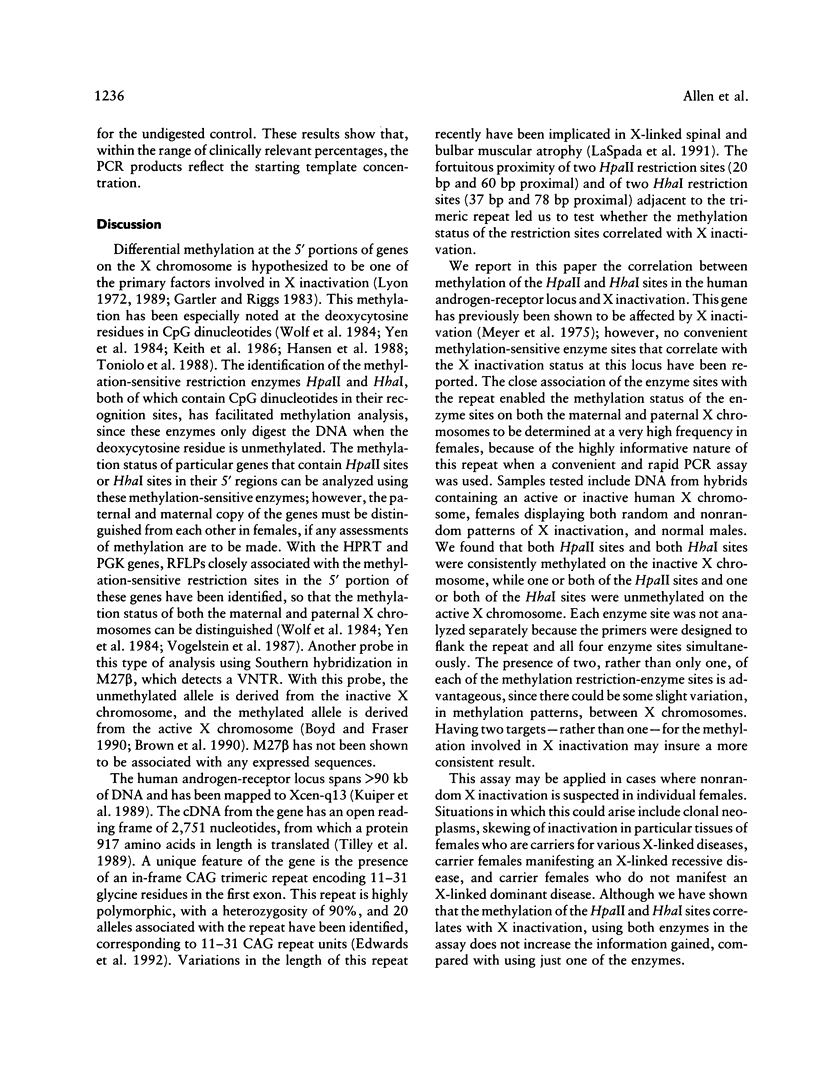
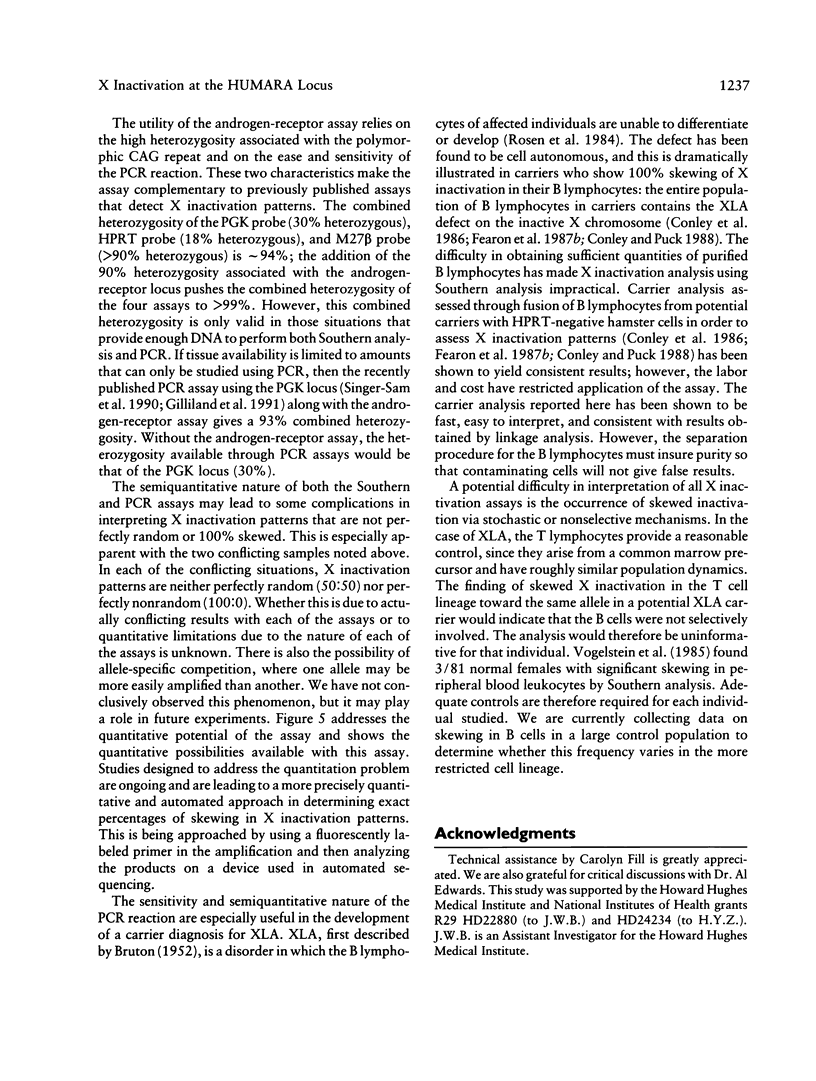
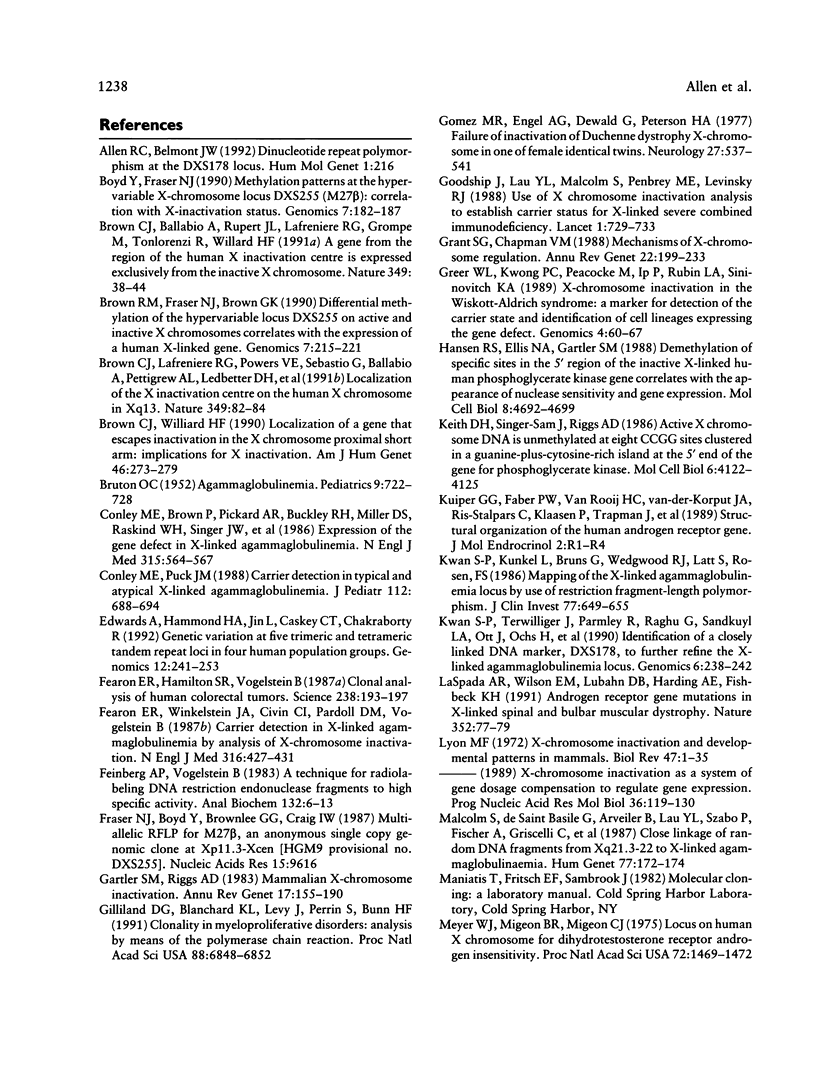
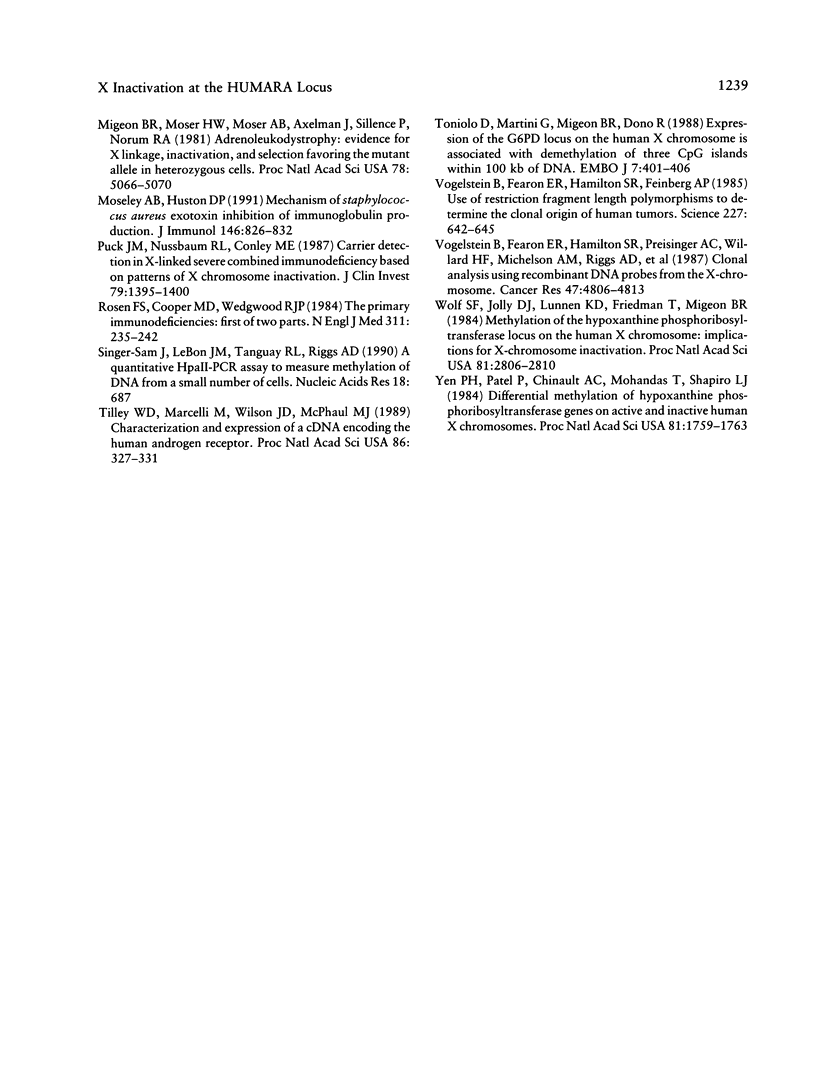
Images in this article
Selected References
These references are in PubMed. This may not be the complete list of references from this article.
- Allen R. C., Belmont J. W. Dinucleotide repeat polymorphism at the DXS178 locus. Hum Mol Genet. 1992 Jun;1(3):216–216. doi: 10.1093/hmg/1.3.216. [DOI] [PubMed] [Google Scholar]
- BRUTON O. C. Agammaglobulinemia. Pediatrics. 1952 Jun;9(6):722–728. [PubMed] [Google Scholar]
- Boyd Y., Fraser N. J. Methylation patterns at the hypervariable X-chromosome locus DXS255 (M27 beta): correlation with X-inactivation status. Genomics. 1990 Jun;7(2):182–187. doi: 10.1016/0888-7543(90)90539-7. [DOI] [PubMed] [Google Scholar]
- Brown C. J., Ballabio A., Rupert J. L., Lafreniere R. G., Grompe M., Tonlorenzi R., Willard H. F. A gene from the region of the human X inactivation centre is expressed exclusively from the inactive X chromosome. Nature. 1991 Jan 3;349(6304):38–44. doi: 10.1038/349038a0. [DOI] [PubMed] [Google Scholar]
- Brown C. J., Lafreniere R. G., Powers V. E., Sebastio G., Ballabio A., Pettigrew A. L., Ledbetter D. H., Levy E., Craig I. W., Willard H. F. Localization of the X inactivation centre on the human X chromosome in Xq13. Nature. 1991 Jan 3;349(6304):82–84. doi: 10.1038/349082a0. [DOI] [PubMed] [Google Scholar]
- Brown C. J., Willard H. F. Localization of a gene that escapes inactivation to the X chromosome proximal short arm: implications for X inactivation. Am J Hum Genet. 1990 Feb;46(2):273–279. [PMC free article] [PubMed] [Google Scholar]
- Brown R. M., Fraser N. J., Brown G. K. Differential methylation of the hypervariable locus DXS255 on active and inactive X chromosomes correlates with the expression of a human X-linked gene. Genomics. 1990 Jun;7(2):215–221. doi: 10.1016/0888-7543(90)90543-4. [DOI] [PubMed] [Google Scholar]
- Conley M. E., Brown P., Pickard A. R., Buckley R. H., Miller D. S., Raskind W. H., Singer J. W., Fialkow P. J. Expression of the gene defect in X-linked agammaglobulinemia. N Engl J Med. 1986 Aug 28;315(9):564–567. doi: 10.1056/NEJM198608283150907. [DOI] [PubMed] [Google Scholar]
- Conley M. E., Puck J. M. Carrier detection in typical and atypical X-linked agammaglobulinemia. J Pediatr. 1988 May;112(5):688–694. doi: 10.1016/s0022-3476(88)80683-8. [DOI] [PubMed] [Google Scholar]
- Edwards A., Hammond H. A., Jin L., Caskey C. T., Chakraborty R. Genetic variation at five trimeric and tetrameric tandem repeat loci in four human population groups. Genomics. 1992 Feb;12(2):241–253. doi: 10.1016/0888-7543(92)90371-x. [DOI] [PubMed] [Google Scholar]
- Fearon E. R., Hamilton S. R., Vogelstein B. Clonal analysis of human colorectal tumors. Science. 1987 Oct 9;238(4824):193–197. doi: 10.1126/science.2889267. [DOI] [PubMed] [Google Scholar]
- Fearon E. R., Winkelstein J. A., Civin C. I., Pardoll D. M., Vogelstein B. Carrier detection in X-linked agammaglobulinemia by analysis of X-chromosome inactivation. N Engl J Med. 1987 Feb 19;316(8):427–431. doi: 10.1056/NEJM198702193160802. [DOI] [PubMed] [Google Scholar]
- Feinberg A. P., Vogelstein B. A technique for radiolabeling DNA restriction endonuclease fragments to high specific activity. Anal Biochem. 1983 Jul 1;132(1):6–13. doi: 10.1016/0003-2697(83)90418-9. [DOI] [PubMed] [Google Scholar]
- Fraser N. J., Boyd Y., Brownlee G. G., Craig I. W. Multi-allelic RFLP for M27 beta, an anonymous single copy genomic clone at Xp11.3-Xcen [HGM9 provisional no. DXS255]. Nucleic Acids Res. 1987 Nov 25;15(22):9616–9616. doi: 10.1093/nar/15.22.9616. [DOI] [PMC free article] [PubMed] [Google Scholar]
- Gartler S. M., Riggs A. D. Mammalian X-chromosome inactivation. Annu Rev Genet. 1983;17:155–190. doi: 10.1146/annurev.ge.17.120183.001103. [DOI] [PubMed] [Google Scholar]
- Gilliland D. G., Blanchard K. L., Levy J., Perrin S., Bunn H. F. Clonality in myeloproliferative disorders: analysis by means of the polymerase chain reaction. Proc Natl Acad Sci U S A. 1991 Aug 1;88(15):6848–6852. doi: 10.1073/pnas.88.15.6848. [DOI] [PMC free article] [PubMed] [Google Scholar]
- Gomez M. R., Engel A. G., Dewald G., Peterson H. A. Failure of inactivation of Duchenne dystrophy X-chromosome in one of female identical twins. Neurology. 1977 Jun;27(6):537–541. doi: 10.1212/wnl.27.6.537. [DOI] [PubMed] [Google Scholar]
- Goodship J., Malcolm S., Lau Y. L., Pembrey M. E., Levinsky R. J. Use of X chromosome inactivation analysis to establish carrier status for X-linked severe combined immunodeficiency. Lancet. 1988 Apr 2;1(8588):729–732. doi: 10.1016/s0140-6736(88)91537-1. [DOI] [PubMed] [Google Scholar]
- Grant S. G., Chapman V. M. Mechanisms of X-chromosome regulation. Annu Rev Genet. 1988;22:199–233. doi: 10.1146/annurev.ge.22.120188.001215. [DOI] [PubMed] [Google Scholar]
- Greer W. L., Kwong P. C., Peacocke M., Ip P., Rubin L. A., Siminovitch K. A. X-chromosome inactivation in the Wiskott-Aldrich syndrome: a marker for detection of the carrier state and identification of cell lineages expressing the gene defect. Genomics. 1989 Jan;4(1):60–67. doi: 10.1016/0888-7543(89)90315-7. [DOI] [PubMed] [Google Scholar]
- Hansen R. S., Ellis N. A., Gartler S. M. Demethylation of specific sites in the 5' region of the inactive X-linked human phosphoglycerate kinase gene correlates with the appearance of nuclease sensitivity and gene expression. Mol Cell Biol. 1988 Nov;8(11):4692–4699. doi: 10.1128/mcb.8.11.4692. [DOI] [PMC free article] [PubMed] [Google Scholar]
- Keith D. H., Singer-Sam J., Riggs A. D. Active X chromosome DNA is unmethylated at eight CCGG sites clustered in a guanine-plus-cytosine-rich island at the 5' end of the gene for phosphoglycerate kinase. Mol Cell Biol. 1986 Nov;6(11):4122–4125. doi: 10.1128/mcb.6.11.4122. [DOI] [PMC free article] [PubMed] [Google Scholar]
- Kwan S. P., Kunkel L., Bruns G., Wedgwood R. J., Latt S., Rosen F. S. Mapping of the X-linked agammaglobulinemia locus by use of restriction fragment-length polymorphism. J Clin Invest. 1986 Feb;77(2):649–652. doi: 10.1172/JCI112351. [DOI] [PMC free article] [PubMed] [Google Scholar]
- Kwan S. P., Terwilliger J., Parmley R., Raghu G., Sandkuyl L. A., Ott J., Ochs H., Wedgwood R., Rosen F. Identification of a closely linked DNA marker, DXS178, to further refine the X-linked agammaglobulinemia locus. Genomics. 1990 Feb;6(2):238–242. doi: 10.1016/0888-7543(90)90562-9. [DOI] [PubMed] [Google Scholar]
- La Spada A. R., Wilson E. M., Lubahn D. B., Harding A. E., Fischbeck K. H. Androgen receptor gene mutations in X-linked spinal and bulbar muscular atrophy. Nature. 1991 Jul 4;352(6330):77–79. doi: 10.1038/352077a0. [DOI] [PubMed] [Google Scholar]
- Lyon M. F. X-chromosome inactivation and developmental patterns in mammals. Biol Rev Camb Philos Soc. 1972 Jan;47(1):1–35. doi: 10.1111/j.1469-185x.1972.tb00969.x. [DOI] [PubMed] [Google Scholar]
- Malcolm S., de Saint Basile G., Arveiler B., Lau Y. L., Szabo P., Fischer A., Griscelli C., Debre M., Mandel J. L., Callard R. E. Close linkage of random DNA fragments from Xq 21.3-22 to X-linked agammaglobulinaemia (XLA). Hum Genet. 1987 Oct;77(2):172–174. doi: 10.1007/BF00272387. [DOI] [PubMed] [Google Scholar]
- Migeon B. R., Moser H. W., Moser A. B., Axelman J., Sillence D., Norum R. A. Adrenoleukodystrophy: evidence for X linkage, inactivation, and selection favoring the mutant allele in heterozygous cells. Proc Natl Acad Sci U S A. 1981 Aug;78(8):5066–5070. doi: 10.1073/pnas.78.8.5066. [DOI] [PMC free article] [PubMed] [Google Scholar]
- Moseley A. B., Huston D. P. Mechanism of Staphylococcus aureus exotoxin A inhibition of Ig production by human B cells. J Immunol. 1991 Feb 1;146(3):826–832. [PubMed] [Google Scholar]
- Puck J. M., Nussbaum R. L., Conley M. E. Carrier detection in X-linked severe combined immunodeficiency based on patterns of X chromosome inactivation. J Clin Invest. 1987 May;79(5):1395–1400. doi: 10.1172/JCI112967. [DOI] [PMC free article] [PubMed] [Google Scholar]
- Rosen F. S., Cooper M. D., Wedgwood R. J. The primary immunodeficiencies (1). N Engl J Med. 1984 Jul 26;311(4):235–242. doi: 10.1056/NEJM198407263110406. [DOI] [PubMed] [Google Scholar]
- Singer-Sam J., LeBon J. M., Tanguay R. L., Riggs A. D. A quantitative HpaII-PCR assay to measure methylation of DNA from a small number of cells. Nucleic Acids Res. 1990 Feb 11;18(3):687–687. doi: 10.1093/nar/18.3.687. [DOI] [PMC free article] [PubMed] [Google Scholar]
- Tilley W. D., Marcelli M., Wilson J. D., McPhaul M. J. Characterization and expression of a cDNA encoding the human androgen receptor. Proc Natl Acad Sci U S A. 1989 Jan;86(1):327–331. doi: 10.1073/pnas.86.1.327. [DOI] [PMC free article] [PubMed] [Google Scholar]
- Toniolo D., Martini G., Migeon B. R., Dono R. Expression of the G6PD locus on the human X chromosome is associated with demethylation of three CpG islands within 100 kb of DNA. EMBO J. 1988 Feb;7(2):401–406. doi: 10.1002/j.1460-2075.1988.tb02827.x. [DOI] [PMC free article] [PubMed] [Google Scholar]
- Vogelstein B., Fearon E. R., Hamilton S. R., Feinberg A. P. Use of restriction fragment length polymorphisms to determine the clonal origin of human tumors. Science. 1985 Feb 8;227(4687):642–645. doi: 10.1126/science.2982210. [DOI] [PubMed] [Google Scholar]
- Vogelstein B., Fearon E. R., Hamilton S. R., Preisinger A. C., Willard H. F., Michelson A. M., Riggs A. D., Orkin S. H. Clonal analysis using recombinant DNA probes from the X-chromosome. Cancer Res. 1987 Sep 15;47(18):4806–4813. [PubMed] [Google Scholar]
- Wolf S. F., Jolly D. J., Lunnen K. D., Friedmann T., Migeon B. R. Methylation of the hypoxanthine phosphoribosyltransferase locus on the human X chromosome: implications for X-chromosome inactivation. Proc Natl Acad Sci U S A. 1984 May;81(9):2806–2810. doi: 10.1073/pnas.81.9.2806. [DOI] [PMC free article] [PubMed] [Google Scholar]
- Yen P. H., Patel P., Chinault A. C., Mohandas T., Shapiro L. J. Differential methylation of hypoxanthine phosphoribosyltransferase genes on active and inactive human X chromosomes. Proc Natl Acad Sci U S A. 1984 Mar;81(6):1759–1763. doi: 10.1073/pnas.81.6.1759. [DOI] [PMC free article] [PubMed] [Google Scholar]




